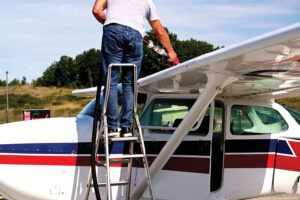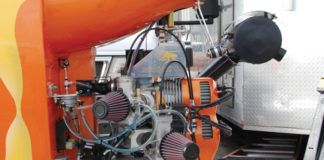
Not a moment after sending our April issue to the press, my editorial “Avgas Next Steps” became partially obsolete. In it, I said that the events at Reid-Hillview Airport in California could presage moves by the Environmental Protection Agency to issue an Endangerment Finding, which would, figuratively speaking, light a fire under the development of a drop-in, unleaded avgas. Just as our magazine was ready to go on press, the EPA did, in fact, signal its intention to issue an Endangerment Finding regarding the lead content of 100LL fuel.
So, now what happens? Predictably, the industry has moved into action with a catchy acronym, EAGLE, which stands for Eliminate Aviation Gasoline Lead Emissions. More on that in a second. It’s worth noting that the EPA does not move quickly. It’s generally accepted that the EPA will take 1–2 years to complete its work toward issuing an Endangerment Finding—and a number of people I’ve spoken to aren’t even convinced it will actually do so. At that stage, the EPA would likely have a public-comment period, after which it would kick the can over to the FAA, which would have to decide how and when to act on the finding. Any rulemaking with the impact of banning leaded avgas would, no doubt, itself have a lengthy comment period, substantial back and forth from agency to industry and, also likely, legal challenges. You can see how the issue could roll out almost endlessly.
Alphabet Soup
For its part, EAGLE, which is made up of the alphabets—AOPA, EAA, etc.—and industry representatives that include airframe/engine manufacturers and the petroleum companies, has pledged to get lead out of avgas by the end of 2030. Remember something I mentioned in April’s column, and that’s that we have evolved our fuel-delivery infrastructure so that it makes the most economic sense to have a single fuel that works in both low-compression O-320s all the way to highly turbocharged TIO-540s and TSIO-550s. It’s accepted that the cost for a small airport operator to install a second set of tanks to run, say, the currently available 94-octane unleaded avgas alongside a high-octane alternative is just too high. (And you know who gets to pay that burden…) All of which means we have to be prepared for a phase-in of the new fuel—and that means no matter what, the new fuel has to be 100% miscible with existing 100LL. We don’t really have the advantage of easing into this over a period of years, at least not from the FBO’s perspective.
The Four Pillars
Back to EAGLE. The program is built on four “pillars” divided between industry and FAA responsibility, and they focus on the fuel itself, regulatory issues (obviously much more a concern for certified aircraft), further research and development and, finally, business infrastructure and implementation.
The new program launched with little mention of GAMI’s (General Aviation Modifications Incorporated) G100UL fuel or even a mention of Swift’s currently available 94UL and its seemingly imminent 100R unleaded, 100-octane fuel. Nor has it really explained why the semi-secret PAFI (the FAA’s Piston Aviation Fuels Initiative) that has been working for nearly a decade has basically nothing to show for its efforts. It’s almost as though a group of intelligent people in both research and industry left the room with a shrug, saying, “Welp, we tried. But no can do.” I can’t bring myself to accept that and am forced to conclude that embedded self-interest and a lack of timely impetus were at work here.
Nevertheless, the movement is on, supposedly with EAGLE at the center of it. I watched a recent seminar hosted by AOPA on the topic and came away appreciating that the program is just getting started, so I wasn’t completely cranky that no simple solutions were offered. I did gain some good insight from Paul Millner as one of the panelists. Full disclosure: I’ve known Paul a long, long time, including when he was a chemical engineer for Chevron in California. He’s written a few avgas pieces for KITPLANES® and other magazines, and I could always count on Paul to make a complex set of chemical reactions come to life in terms I could understand. His knowledge of the subject is combined with the rare skill of clear, concise storytelling.
The Playing Field
During the AOPA seminar, Millner was asked about the fuels we’ve seen so far, from GAMI and Swift, and offered a broad opinion. “It’s very promising. I’ve looked at both GAMI’s work and Swift’s work. The nice thing about the STC process is that the applicants have published patents,” he said, underlying that both firms have applied for approval to be used in certified aircraft through a supplemental type certificate. (Experimental aircraft are not bound by that.) “If you’re able to do a Google search… you can read all about what’s in their fuel and how they plan to make it. Those formulations have evolved greatly over the last decade. The technical issues have been addressed, the materials compatibility is quite clear that it’s not going to be an issue with at least those two fuels and the performance seems to be there. So I think it’s a very promising time.”
Millner noted that the PAFI process, which was kept hidden from the public presumably to preserve intellectual property, was not transparent. And it’s worth mentioning that no other company besides GAMI and Swift has come forward with what appears to be a viable replacement for 100LL. Another fuel supposedly making the rounds counts on an additive called MMT (methylcyclopentadienyl manganese tricarbonyl) to boost octane. But there are concerns about deposits forming with this additive, which were observed in Canada when used at higher concentrations, though still only just a fraction of the concentration proposed for avgas. However, this fuel may require development of special spark plugs to combat deposit formation.
If you think about deposits, it would be tough to come up with a fuel much worse that our current leaded avgas. There’s little doubt that moving to an unleaded fuel will benefit the engines we run. There will be less junk in the oil, fewer deposits on the plugs and valve stems. And getting rid of lead would allow development of a truly modern synthetic oil. Think about that.
Paul commented on the supply-chain considerations, highlighting something I hadn’t fully considered. Right now, 100LL has to be blended and transported very carefully—adding cost on top of being low volume—and the blenders have to accept “lead liability.” 100LL is made in only eight plants in the U.S. That, by itself, reduces the number of places 100LL can be produced. An unleaded fuel, which is likely to be made up of very common base stocks with a special cocktail of octane-improving additives, could be blended by companies that currently won’t take on the lead liability. “The more people that play [is good]. Competition is an amazing thing. Mogas has about a 4-cent/gallon margin; avgas has about an 80-cent/gallon margin,” Paul says, which makes it an attractive proposition for new producers if they don’t have the lead liability.
Later in the discussion, Paul points out how historically the fuel industry has “competed away” margins in the marketplace (swapping margin for volume), and GAMA president Pete Bunce referred to what he’s seen in sustainable jet fuel that the early efforts were actually more expensive than the incumbent but that demand pushed supply up, and that resulted in leveling (lower) prices.
Which leaves me with a question still seeking an answer: Are the obstacles to replacing conventional, leaded avgas with an unleaded alternative much less technical and a lot more about preserving that 80-cents-a-gallon margin for the legacy suppliers?
UPDATE: There was significant discussion on the future of avgas at Sun ‘n Fun this year, which prompted me to pick up the issue in the following editorial to appear in our July issue. However, to keep this current, here’s that segment.
“If it were a simple solution, it would have been done by now,” said AOPA’s president, Mark Baker, at Sun ’n Fun this year. He, GAMA’s Pete Bunce and EAA’s Jack Pelton had a town hall meeting and fielded questions about the future of avgas and the goals of EAGLE, the new initiative that you aren’t supposed to call PAFI Version 2.
In a statement that shocked me, Bunce told the group that PAFI wasn’t about finding an unleaded replacement for 100LL but to determine testing and approval protocols. Very narrowly defined, that could possibly be argued, but I don’t know anyone, inside or outside of aviation media, who thought PAFI was not intended to deliver a usable unleaded avgas. Which makes me wonder: If it was only to determine testing, why was so much of it kept secret?
Context is everything: The day before these industry leaders spoke, George Braly, whose GAMI G100UL has already been awarded an STC for select Lycoming engines, expertly laid out a chain of events that started in 2010 with a working solution to leaded avgas. You’ll surely remember that GAMI was granted an STC for certain Lycoming engines at AirVenture last year and immediately set about working on a broader STC that would encompass virtually every aviation piston engine.
In his forum, Braly recounted how GAMI had jumped through every hoop the FAA placed in front of it and was on the cusp of receiving the much larger STC when FAA management called for an independent review of the data. That started in December and was completed in early January, and by early March the local certification office said that GAMI had successfully come through the review and met the requirements of the expanded STC, noting that the final signoff was waiting only one final FAA approval.
The FAA then initiated what amounts to an executive order for GAMI’s product to be the subject of a technical advisory board (TAB), which is made up of industry experts. Not only had GAMI already been given a base STC for G100UL, the TAB process wasn’t even new; it had done five of them previously dating back to 2010.
In the Wednesday town hall at Sun ’n Fun, GAMI’s work was barely mentioned. Instead, there was a lot of talk about the lack of transparency in the process. It’s true that GAMI has a “secret sauce” of additives that take G100UL from a common base fuel to a fully fungible, drop- in replacement for 100LL, and I read the resistance as the industry being unhappy that they don’t know the ingredients. But here’s the problem with that: The FAA has already given its approval to the fuel via the existing STC and knows key elements of the spec.
And given the fact that the great majority of GAMI’s testing was conducted on the “worst case” engine most susceptible to detonation, additional scrutiny to expand the STC can only be read as one thing: an effort to slow the process to let other companies catch up. I sincerely hope the sides can start working together on this. As my colleague Paul Bertorelli wrote in a contemporary op-ed appearing on AVweb.com during the show (titled “FAA, Do Your Damn Job“), “It’s not clear from the outside looking in how much influence the majors— Phillips, Exxon, Shell, BP—have on the politics and process here. They…have a vested interest in the leaded status quo and no incentive to produce G100UL under license, even though I suspect these discussions are going on.”
As if to prove the political aspects of a replacement for 100LL are just as fluid as the technology itself, during the last days of Sun ’n Fun, the FAA revealed that Earl Lawrence, the top administrator on whose desk GAMI’s broader STC is waiting, is being replaced by Lirio Liu, previously the executive director in the Office of International Affairs for the FAA. Whether this helps break the logjam in the FAA or sets up new ones remains to be seen. Bottom line: EAGLE has promised an unleaded replacement by the end of 2030. Once the EPA makes its finding of endangerment, we probably won’t have that long. There’s truly no time to waste.














All this time, no fuel!
GAMI and Swift have produced viable fuels, and roadblocks are being put in the way.
There is no good reason that we don’t have an unleaded fuel; fire some people in the responsible agencies!
Marc,
Nice article. Appreciate your personal comments and insights as well. There’s no doubt much more to this story than is generally discussed. Cannot help but think of one of the many basic ethos that define how much of the world operates – “follow the money”.
CS
Companies should be reward for their efforts, but I have a hard time giving the keys to just one company. The lack of a market is a monopoly. At least with an STC, more players can throw their hat into the ring. But is this the best approach for something so fundamental to the industry?
Is AOPA, EAA, and GAMA putting up any money to support this transition? They have a vested interest insuring that this doesn’t go sideways. If the $olution is worse than the problem, then we no longer need these organizations. The only organization within EAGLE that has the engineering skills and resource is the FAA.
Maybe we need an XPrize like contest to incentivize research by academia and industry. EAGLE are you listening?
Been wondering why GAMI has been getting so little mention by EAGLE. Sounds like a no brainer to push their fuel over the finish line. GAMI has made the investment in time and money. If they’re the only one, then that’s not their fault and they should be allowed to bring it to market. The big players are behind because of their own intransigence, and the FAA shouldn’t be holding things up so they catch up.